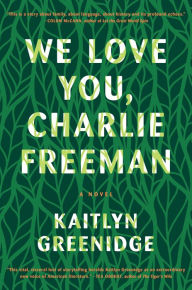We Love You, Charlie Freeman
- By Kaitlyn Greenidge
- Algonquin Books
- 336 pp.
- Reviewed by Tara Campbell
- February 17, 2016
This debut novel tackles risky terrain: race, language, identity — and chimpanzees

Author Kaitlyn Greenidge is not one to play it safe. Her first novel takes on race, ambition, language, integrity, and identity in a charged atmosphere that blurs the lines between human and animal. In We Love You, Charlie Freeman, she places an African-American family in the middle of a controversial experiment, living side by side with Charlie the chimpanzee at the mysterious Toneybee Institute for Ape Research.
The experiment is ostensibly about language acquisition in primates — the Freemans know sign language and are hired to live at the institute and teach it to Charlie. Laurel Freeman, the mother, is the driving force behind the family’s involvement in the project. She’s a sign-language instructor who has never been able to rise in her field because of her insistence on using black sign language rather than standard. (Interestingly, no one in the family is deaf — Laurel learned sign language out of curiosity as a child, and has passed it along to her children out of her passion for it.)
She convinces her husband, Charles, and two daughters, 14-year-old Charlotte and 9-year-old Callie, to leave their lives in Boston behind and live at Toneybee, a primate research facility operating under the shadow of a dark past.
Early on, Greenidge gives the reader indications that questionable things are afoot at the institute. We get a peek of Dr. Paulson’s dry, yellowish tongue flicking over a stub of chalk she’s in the habit of eating. We see an ominous portrait of the institute’s wealthy founder, a thin white woman with “the gaze of a zealot,” posing next to the bones of the first chimp she ever owned. Even the smells of the place raise the hairs on the backs of our necks: “The hallway smelled like furniture polish and rotting brocade and underneath that something else, something warm and dark and rude. Wild animals.”
The exact nature of the experiment remains hazy, but the obsessiveness with which institute staff interview and videotape the Freeman family suggests that Charlie is not the only one being studied. Greenidge bolsters this suspicion by interspersing the present narrative with chapters set in 1929, through which we discover more details of the institute’s previous research involving apes and African-Americans.
In the storyline from the past, a proud but lonely black teacher named Nymphandoria, a “spinster” at 36, begins an unlikely friendship with a British doctor at the institute. Charmed, she allows him to draw her portrait for research, and our hearts sink with hers as she finds herself drawn into his increasingly degrading research agenda.
Greenidge’s prose is rich and evocative, replete with sensual details. Her attention particularly to the sense of smell is remarkable: “Charlie yawned. His breath was rancid, like dried, spoiled milk. Later, when he got used to us, he would run his lips up and down our hands so that all of our skin, too, smelled like Charlie’s mouth and the hefty, mournful stench of wild animal.”
The author’s skill lies in not letting her vibrant descriptions slow the pacing of the novel. She starts with a light, refreshing tone; and pages of delightful, breezy prose melt away under our hands as she coaxes us into increasingly dark and uncomfortable territory.
Although Greenidge’s language flows, her characters aren’t easy — not even the chimpanzee, who is more often fractious than charming. And she expertly captures Charlotte’s angsty teenage contrariness when the family first arrives at the institute: “I’d already decided, months ago, when I’d first heard her name that I would not allow myself to like Dr. Paulsen.” Even the bucolic landscape on the way to their new home is a “belligerent green” in the disgruntled girl’s eyes.
The Freemans are all complex and at times inscrutable as they alternately acknowledge and deny their doubts about the experiment they’re contractually obliged to finish. Both the family and the institute have complicity, having gone into it for their own reasons, and neither side is completely within rights to point fingers at the other.
While the father and daughters begin to flag under Charlie’s difficult behavior and the constant scrutiny of the scientists, the mother remains steadfastly attached to both the chimpanzee and the project. The central question of the novel becomes how long the Freemans will actually last at the institute, or indeed, remain intact as a family.
To get the most out of this conflict, however, I would have liked to have a little clearer sense of why the mother was so deeply and immutably attached to Charlie. Laurel reflects early on that she knew she loved him even before she met him, yet I struggled to understand exactly why she would be willing to risk the cohesion of her family for him.
And on a completely nitpicky note, writers are normally cautioned against having so many characters with similar names in the same manuscript (Charles and Charlie, Charlotte and Callie). While I suspect this selection of names alludes to the scientists’ shaky grasp on the line between African-Americans and chimps, I did have to stop early on to remind myself whether Charlotte or Callie was the older sister.
But Greenidge easily overcomes initial name confusion with her vivid characterizations, rendering this a small matter in comparison with the other achievements of the novel. We Love You, Charlie Freeman is a gripping and gratifying read. Greenidge tackles the risky terrain of ethnicity and race relations with confidence and grace, and has proven herself a writer to watch.
With a BA in English and an MA in German, Tara Campbell has a demonstrated aversion to money and power. She volunteers with 826DC and the Washington Writers Conference, and reads her crossover sci-fi at the Inner Loop and the lowercase.

